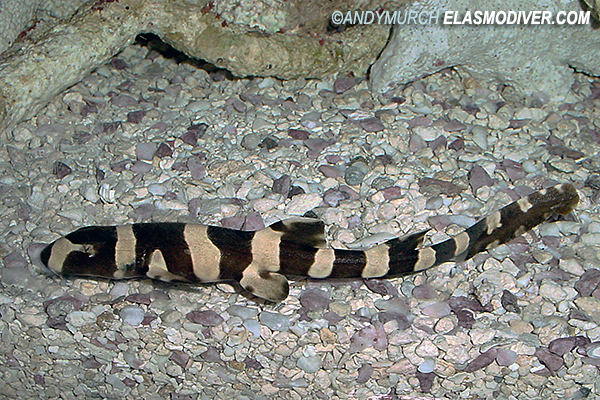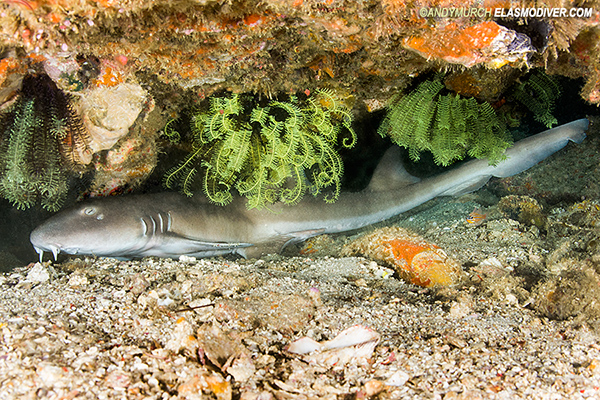|

Juvenile brownbanded bamboo shark

Adult
brownbanded bamboo shark
View more
Brownbanded
Bamboo Shark images
in the
Shark Pictures Database
Common
Names:
Brownbanded bamboo
shark, banded bambooshark, banded catshark.
Latin
Name:
Chiloscyllium punctatum
Family:
Hemiscyllidae
Identification:
Elongated tan/brown body.
Lateral groove on each flank running
from behind head to base of tail.
Juveniles have bold dark bands (without black edging) against a tan background.
Dark bands fade in adulthood but often remain faintly visible. Occasionally, a
few scattered small black spots on head and torso.
Dorsal fins relatively large with
concave rear margin. Anal fin set far back at base of tail. Snout rounded. Barbells extend
from nares to mouth. Spiracle slightly smaller than, and positioned below and
slightly behind eye. Short gill slits. Gill slit margins are noticeably pale.
Size:
Maximum length 132cm. 11-15cm at birth. Males mature around 82cm. Females mature
around 87cm.
Habitat: Coral
reefs and possibly sandy substrates from intertidal zone to approx 85m.
Occasionally found in tide pools. Able to survive for extended periods above
water i.e. up to half a day between tides.
Abundance
and distribution: Indo Pacific.
East India, and South East Asia
from Japan to Northern Australia.
Behavior: Nocturnal. Hides
by day in
crevices on the reef or under corals. Hunts
for bony fishes and crustaceans.
Reproduction:
Oviparous.
Lays up to 153 rounded egg cases. Eggs hatch after around 90 days.
Conservation Status:
Considered 'Near Threatened' by the IUCN. Within Australia the species is
assessed as Least Concern as a portion of its habitat is protected in marine
parks and it is not a target species, except perhaps for the aquarium trade. It
is an extremely hardy species that would presumably survive as a discard in any
trawl bycatch. However, throughout much of the rest of its range, the species is
likely to be threatened by overfishing for human consumption, habitat loss due
to destructive fishing methods on coral reefs, and collection for the
display-aquarium trade. It fails to meet the criteria for Vulnerable due to
insufficient data, but is assessed as Near Threatened globally because of
concern over the significant impact that these practices must be having on this
species in much of its range.
Citation:
Bennett, M.B. & Kyne, P.M. (SSG Australia & Oceania Regional Workshop, March
2003) 2003. Chiloscyllium punctatum. The IUCN Red List of Threatened Species.
Version 2014.3. <www.iucnredlist.org>
Photographs:
Sambawam Island, Philippines.
Similar species:
The brownbanded bamboo shark partially shares its range with a number of other bamboo
sharks, some of which look quite similar especially during the juvenile banded
stage.
The grey bamboo shark Chiloscylliam
griseum has dorsal fins with straight or convex rear margins.
The Burmese bamboo shark
Chiloscylliam burmensis
is a more slender animal with dark fin webs on all fins and convex rear margins.
The Indonesian bamboo shark
Chiloscylliam hasselti has dusky edged fins with convex rear margins.
Reaction to divers:
Generally very shy and wary
of divers. When discovered under ledges, the brownbanded bamboo shark usually
tries to wedge itself deeper. If no better cover is available, it will bolt for
another hiding place.
Diving
logistics: The brownbanded bamboo shark is a fairly common but
rarely seen shark inhabiting many popular dive sites in Southeast Asia and
Northern Australia. It is reportedly common in Moreton Bay, Queensland, Australia; a
site with limited cover where multiple animals can be found sharing the same
crevices.
HOME
LINKS TAXONOMY
UNDER THREAT
BOOKS CONTACT
|























